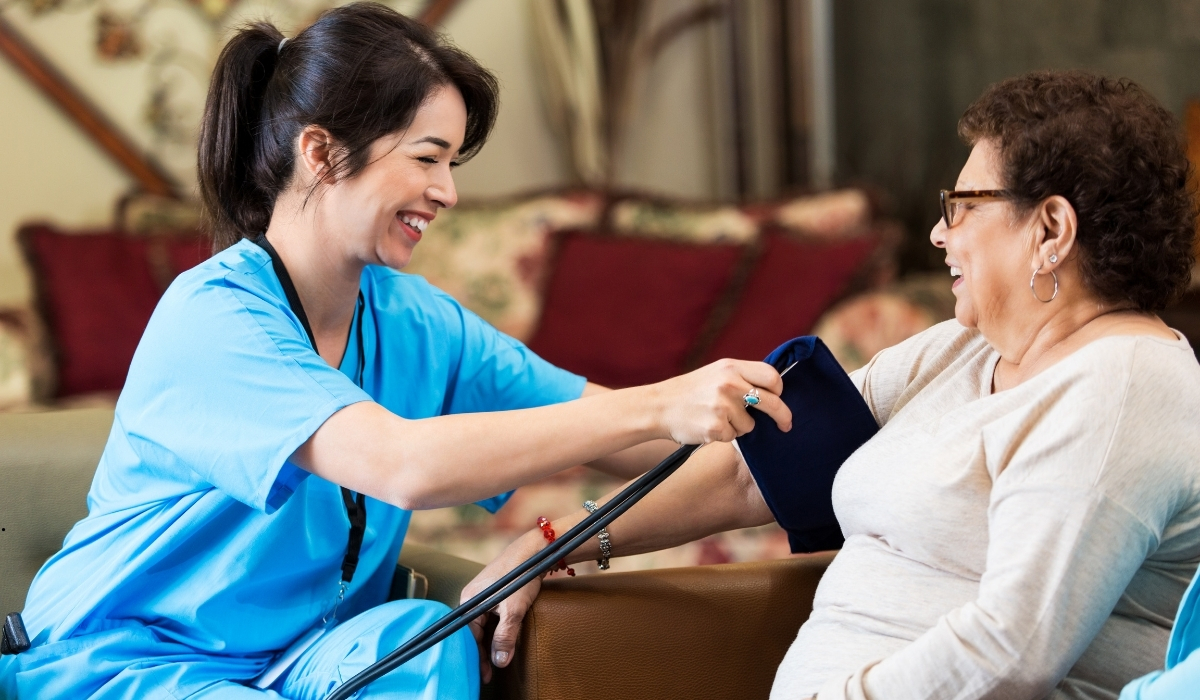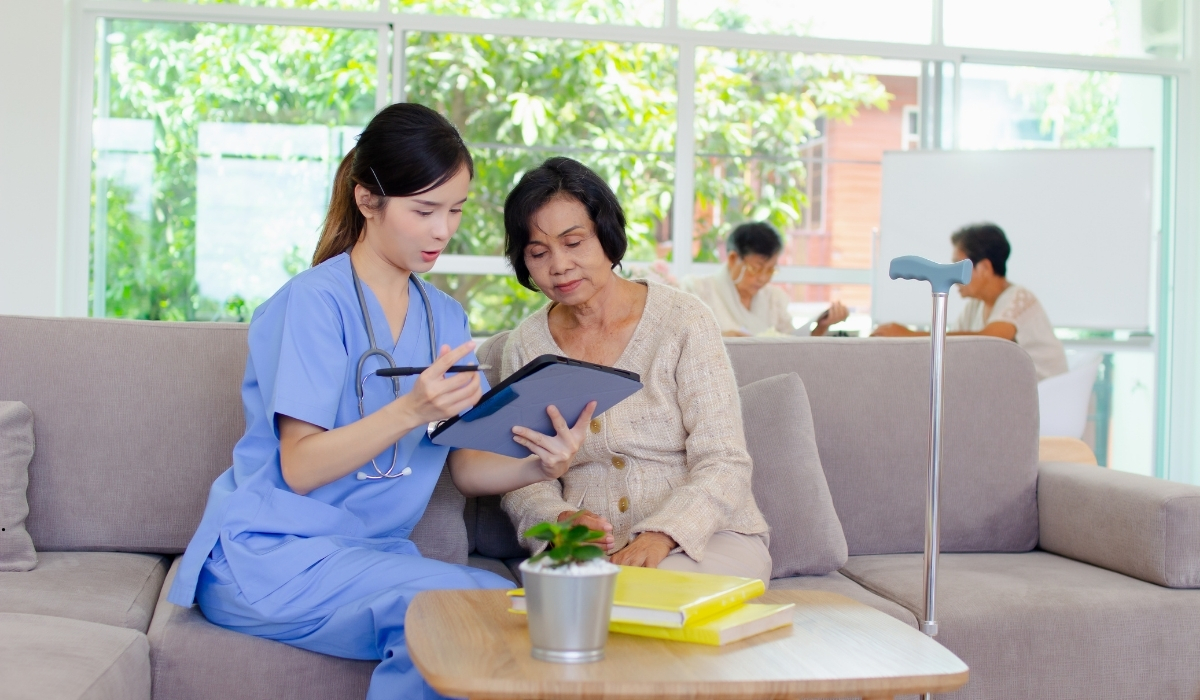Introduction
Overview of Lamset Haya Elderly Care Home
Design Standards for Safe Accommodation Rooms for the Elderly
Standards of Sustainable Cleanliness
Medical and Operational Care Inside the Room
The Psychological and Social Dimension of the Accommodation Room
Implementation Challenges and How to Overcome Them
Linking Theory to Practice
Practical Recommendations
Conclusion

Introduction: Why Do We Care About Clean and Safe Accommodation for the Elderly?
As people age, their bodies become more fragile, some senses like balance and vision weaken, and older adults become more susceptible to health complications than younger individuals. Under these conditions, the physical environment surrounding them — especially their living spaces — becomes a crucial factor in the quality of their daily lives for several reasons:
Prevention of Infections
With age, the immune system weakens, making seniors more vulnerable to infections. Rooms that lack cleanliness and continuous disinfection can become breeding grounds for bacteria and fungi.
Prevention of Accidents and Falls
Many injuries among the elderly occur due to falls inside the home or care facility. An unsafe room — with slippery floors, unstable mirrors, sharp-edged furniture, or poor lighting — increases the likelihood of such accidents.
Emotional Comfort and Dignity
It’s not only the physical aspects that matter but also the feeling that the place is respectful and values human privacy. A tidy, quiet room with a personal touch contributes significantly to the resident’s sense of belonging and psychological comfort.
Consistency of Quality Care
A resident’s room is not just a place to sleep; it’s also where essential care services are provided (such as nursing, medication distribution, meals, and social activities). Therefore, if the room is well-designed and properly equipped, the overall quality of care improves.
In conclusion, discussing clean and safe accommodation for the elderly is not a luxury — it’s a vital necessity to ensure that the final chapter of life is lived with dignity and quality.
Overview of Lamset Haya Elderly Care Home and Its Vision for Dignified Living for Seniors
Before diving into details, it’s worth taking a look at Lamset Haya Elderly Care Home as a practical example:
Lamset Haya offers a wide range of services that include specialized accommodation for the elderly, medical care, cognitive and social activities, assistance with eating and dressing, rehabilitation, and more.
On their website, it’s mentioned that they accommodate cases requiring ongoing medical follow-up—such as Alzheimer’s patients, individuals in need of rehabilitation, or those with multiple health conditions.
Their accommodation standards emphasize variety in room options (single, double, and shared rooms) according to the resident’s or family’s preference, with a strong focus on daily cleanliness, safety, psychological comfort, and privacy.
Using this example, we can connect theory with real-world application—illustrating how standards are implemented in practice and identifying potential gaps that may arise within such institutions.
Design Standards for Safe Accommodation Rooms for the Elderly
In this section, we review the essential design standards that must be considered when designing or equipping a room for an elderly person.
1. Space and Movement
Corridor Width:
The corridors inside the room and those leading to it must be wide enough to accommodate a wheelchair, walker, or assisted walking.
Minimize Floor Level Differences:
Even small level differences (a step or a few centimeters) can pose a serious hazard or cause tripping. It’s best to have completely level flooring.
Avoid Furniture Crowding:
Avoid placing too many small or unnecessary pieces of furniture that narrow the space or create tripping hazards.
Define Clear Pathways:
Inside the room, there should be a clear, obstacle-free pathway from the entrance to the bed, the bathroom, and any other facilities.
2. Flooring and Materials
Non-Slip Flooring:
Use non-slip tiles, rubber flooring, or anti-slip materials—especially in areas prone to moisture (like balconies or near windows).
Avoid Loose Carpets or Use Fixed Ones:
If carpets are used, they must be fully secured to prevent curling edges or tripping hazards.
Easy to Clean:
Floor and wall materials should be easy to clean and disinfect.
Smooth Transitions Between Materials:
If two different materials are used on the floor, the edges must be smooth to avoid obstacles.
Rubber Mats in Key Areas:
Use rubber mats near the nursing bed or areas where medical equipment is used on the floor.
3. Lighting and Ventilation
Adequate and Balanced Lighting:
Provide good general lighting, along with localized lighting (such as bedside or reading lamps).
Low Night Lighting:
Provide soft night lighting to reduce the risk of falls if the resident wakes up at night.
Reduce Harsh Contrast:
Strong contrasts between bright and dark areas can disorient elderly individuals, so lighting should be evenly distributed.
Maximize Natural Light:
Use large windows when possible, while ensuring protection from excessive sunlight and maintaining privacy.
Proper Ventilation:
Ensure natural or mechanical ventilation to maintain air quality, reduce humidity, and prevent odors.
4. Doors and Windows
Wide Doors:
Doors should be wide enough to accommodate wheelchairs or walkers.
Easy to Open and Close:
Doors should have simple mechanisms or handles suitable for those with weak hands.
Safe Windows:
Windows should have easily accessible locks, shatter-resistant glass if possible, and low handles for easy opening.
Adjustable Curtains or Blinds:
Allow residents to control lighting without much effort.
5. Bed and Rest Area
Proper Bed Height:
The bed should neither be too low nor too high—allowing easy sitting and standing.
Adjustable Medical Bed:
Ideally, the bed should allow raising or lowering the head and foot sections for comfort and medical needs.
Retractable or Fixed Side Rails:
Provide additional safety during sleep or movement.
High-Quality Medical Mattress:
Flexible and body-supportive, reducing the risk of pressure sores or injuries.
Convenient Side Table:
Essential items like medication or a call phone should be within easy reach.
6. Bathroom and Sanitary Facilities
Bathrooms are among the most hazardous areas and can become hotspots for slips and falls if not designed carefully.
Direct Access from the Bed if Possible:
Or minimize the distance to reduce the need for long movement.
Non-Slip Flooring Inside and Outside the Bathroom
Barrier-Free Passage Between Room and Bathroom
Grab Bars:
Install grab bars beside the toilet, shower, and bathing areas.
Barrier-Free Shower:
Or at least one with the lowest possible threshold.
Fixed and Comfortable Shower Seat
Toilet at a Suitable Height:
Slightly elevated for ease of use.
Easy-to-Use Faucets and Handles:
Prefer lever handles over small knobs.
Well-Placed Lighting in the Bathroom
Good Ventilation:
To reduce humidity and prevent mold growth.
Window or Exhaust Fan
Properly Positioned Mirror:
Useful even when the resident is seated.
7. Furniture and Accessories
Stable and Sturdy Furniture:
Pieces should be large and firm enough to support the user if they lean for balance.
Chairs with Proper Height and Armrests:
To make sitting and standing easier.
Avoid Sharp Edges:
Opt for rounded corners or edge protectors.
Easily Accessible Storage:
No need for excessive bending or pulling.
Shelves Within Easy Reach:
Reduce the need for overhead stretching or ladders.
Easy-to-Grip Handles and Controls:
For drawers, doors, and zippers.
Scratch-Resistant and Easy-to-Clean Surfaces
Mirror at an Appropriate Height
8. Smart Safety Systems
Emergency Buttons or Call Bells:
Installed near the bed and in the bathroom.
Motion Sensors:
To detect nighttime movement or falls.
Optional CCTV Cameras:
In hallways (based on privacy policies).
Internal Alarm System:
Connected to nursing staff or the medical center.
Safe Electrical Systems:
Concealed or organized wiring, protected outlets, and easy-to-use switches.
Smoke Detectors and Fire Alarms
Gas or Water Leak Detectors:
Especially if the room includes a kitchenette or water system.

Standards of Sustainable Cleanliness and Disinfection in Accommodation Rooms
After good design comes the importance of sustainability in cleanliness and disinfection — because design alone is not enough without strict and regular maintenance. Here are the main standards:
1. Daily Cleaning and Disinfection Schedule
-
Clean all surfaces (tables, handles, handrails) with safe disinfectants
-
Sweep and mop floors daily
-
Change and disinfect linens and bedding regularly (for example, twice a week or as needed)
-
Clean and disinfect bathrooms several times a day
-
Ventilate rooms daily to renew air circulation
-
Use disinfectants in critical touchpoints (such as doorknobs, switches)
-
Perform internal cleaning of medical equipment, if available
2. Selection of Disinfectants and Cleaning Products
-
Use safe, health-approved disinfectants free from heavy metals or harmful chemicals
-
Choose products certified by health authorities
-
Ensure disinfectant residues are properly rinsed off or the area is ventilated afterward
-
Use mild cleaners when possible to reduce impact on skin and lungs
3. Management of Bedding, Curtains, and Pillows
-
Regularly disinfect pillows and blankets
-
Use antibacterial covers for pillows and mattresses
-
Clean or replace curtains as needed
-
Use easily washable materials
4. Waste Management and Safe Disposal
-
Provide designated containers for medical waste, if applicable
-
Separate regular waste from hazardous waste
-
Follow proper health regulations for waste disposal
-
Immediately dispose of any wet or contaminated materials
-
Regularly disinfect waste bins
5. Ventilation and Air Quality Control
-
Maintain effective ventilation (via windows, fans, or air conditioners with HEPA filters when possible)
-
Use air purifiers if feasible
-
Monitor humidity levels — keeping them moderate to prevent mold growth
-
Avoid strong odors or air fresheners that may irritate the respiratory system
6. Regular Maintenance of Facilities and Systems
-
Periodically inspect plumbing systems (faucets, drainage) to prevent leaks
-
Regularly check electrical systems
-
Repair any floor or wall damage immediately
-
Ensure the safety and functionality of medical equipment (such as blood pressure or oxygen monitoring devices)
Medical and Operational Care Inside the Room
The accommodation room is not just a physical space — it represents the intersection between environment and healthcare. Here’s how care can be integrated within the resident’s room:
1. Nursing and Monitoring
-
A specific nursing plan is prepared for each resident based on their condition.
-
Regular visits by nurses to monitor the resident’s health status.
-
Recording of symptoms and any changes in the resident’s condition.
-
Monitoring of vital signs (blood pressure, pulse, respiration, temperature) according to a set schedule.
-
Training the care team on rapid response to emergency situations.
2. Medication Distribution and Management
-
Implementing a medication schedule inside the room (using a simple board or notebook to record timings).
-
A dedicated and easily accessible shelf for medications.
-
The nurse or assistant administers doses at the specified times.
-
Monitoring for any side effects or interactions and reporting them to the doctor.
3. Meal Service Inside the Room
-
Option to serve meals in-room for residents who prefer not or are unable to leave.
-
Meals are customized (liquid, mashed, or light) according to the resident’s condition.
-
Use of safe and easy-to-handle utensils (cups with covers, ergonomic spoons, lightweight plates).
-
Ensuring meals are served in a stable and safe area within the room.
4. In-Room Stimulation Activities
-
Providing a small library (books, magazines, Qur’an, or religious texts).
-
Simple entertainment tools (radio, small TV, mental games).
-
Light handcraft activities (coloring, simple sewing, small-scale manual crafts suitable for abilities).
-
Organizing social or external interaction (family visits, music listening sessions).
5. Privacy and Communication
-
Ensuring the resident’s privacy is respected (no entry without permission except in emergencies).
-
Allowing the resident to receive visitors comfortably.
-
Providing a small seating area within the room for visitors.
-
Allowing residents to personalize their room (family photos, personal belongings).

Implementation Challenges and How to Overcome Them
Even with good knowledge and intentions, institutions or families may face several challenges when applying the standards in real-life settings. Below are the main challenges and some suggested solutions:
| Challenge | Possible Causes | Suggested Solutions |
|---|---|---|
| Limited Budget | Cost of high-quality flooring, safety equipment, smart systems | Apply improvements gradually; prioritize (start with the most critical, such as safe flooring). |
| Lack of Training | Staff may not know how to properly deal with elderly residents | Conduct regular training sessions and workshops; ensure professional supervision. |
| Resistance to Change from Residents or Family | They may perceive changes like sensors or monitoring devices as intrusive | Provide awareness sessions; involve the resident in decision-making; clearly explain the benefits. |
| Ongoing Maintenance | Regular follow-up and maintenance might be neglected | Set a fixed maintenance schedule; assign monitoring teams; allocate a specific maintenance budget. |
| Infrastructure Challenges | Old buildings may not easily accommodate major modifications | Use partial solutions such as installing lifts, adding ramps, or lowering stairs. |
| Resistance to Technology Use | Some residents or staff may refuse to use smart systems | Choose simple, user-friendly systems; introduce technology gradually through training. |
Linking Theory to Practice: How Does Lamset Hayah Apply the Standards?
By examining the Lamset Hayah website and its article “Clean and Safe Accommodation for the Elderly,” we can observe how theoretical principles are translated into real-life practices:
Variety of Accommodation Options
Lamset Hayah allows residents to choose the room type that suits them best — single, double, or shared. Lamset Hayah Elderly Care Home.
Daily Cleaning and Disinfection System
Their website notes that cleanliness is monitored daily, with beds and linens disinfected regularly — especially for residents who spend long periods in bed. Lamset Hayah Elderly Care Home.
Thoughtful Interior Design
They mention that each room’s design is tailored for senior comfort — including soft night lighting, adjustable beds, non-slip floors, and nearby bathrooms equipped with support rails. Lamset Hayah Elderly Care Home.
In-Room Medical Care
The website explains that they have a system for medical and nursing supervision, medication management, and routine checkups within the rooms — without making the resident feel “constantly monitored.” Lamset Hayah Elderly Care Home.
Psychological Well-being and Privacy
Lamset Hayah encourages residents to personalize their rooms by bringing items from home, creating space for personal memories, and ensuring privacy during times they prefer solitude. Lamset Hayah Elderly Care Home.
Family Involvement and Transitional Stays
Lamset Hayah also highlights that some families opt for temporary stays — for example, during recovery periods — demonstrating flexibility in handling various cases. Lamset Hayah Elderly Care Home.

Practical Recommendations and Tips for Applying Standards in Your Environments
Here is a set of practical recommendations you can apply — whether you are setting up a care home or preparing a room at home for an elderly person:
Start with a Comprehensive Assessment
Study the existing room or floor plan, and identify risky or weak points (slippery floors, poor lighting, tight spaces, etc.).
Set Your Priorities
Not all modifications are required immediately — focus first on high-risk areas such as flooring, glass surfaces, and sensors.
Consult Health and Architectural Experts
Combining medical expertise with architectural design produces better results.
Choose Quality Materials and Products Within Budget
You can start with mid-range products and upgrade over time.
Maintain Regular Maintenance
Create a fixed maintenance schedule and periodic assessment tasks to ensure continued performance.
Train the Staff
Train them on how to interact with elderly residents, use equipment, respond to emergencies, and recognize warning signs.
Involve Residents and Families in Decision-Making
Listen to their needs and involve them in choosing colors and simple room elements.
Evaluate Performance Regularly
Use indicators such as the number of incidents, resident satisfaction, and cleanliness reviews to support continuous improvement.
Stay Updated with Technology
Gradually invest in smart devices such as motion sensors, monitoring systems, or alarms—provided they are safe and easy to use.
Emphasize the Human Aspect
The human relationship between staff and residents—based on respect and kindness—is what transforms the room from a mere living space into a warm, safe home.
Conclusion
A clean and safe accommodation room for the elderly is not a distant dream, but an achievable goal when good vision, thoughtful design, consistent healthcare, and sustainable cleanliness come together. Lamsat Hayah Home stands as a living example of how these principles can be translated into a reality that offers residents dignity and comfort.
